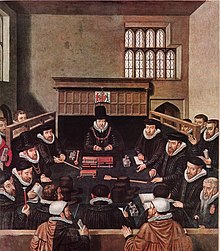
| Court of Wards Act 1540 | |
|---|---|
| Act of Parliament | |
 | |
| Long title | An Act for the Establishment of the Court of the King's Wards. |
| Citation | 32 Hen. 8. c. 46 |
| Dates | |
| Royal assent | 24 July 1540 |
| Other legislation | |
| Repealed by | Tenures Abolition Act 1660 |
Status: Repealed | |
| Wards and Liveries Act 1541 | |
|---|---|
| Act of Parliament | |
 | |
| Long title | An Act concerning the Order of Wards and Liveries. |
| Citation | 33 Hen. 8. c. 22 |
| Dates | |
| Royal assent | 1 April 1542 |
| Other legislation | |
| Repealed by | Tenures Abolition Act 1660 |
Status: Repealed | |
The Court of Wards and Liveries was a court established during the reign of Henry VIII in England. Its purpose was to administer a system of feudal dues; but as well as the revenue collection, the court was also responsible for wardship and livery issues.
The court was established from 1540 by two Acts of Parliament, Court of Wards Act 1540 (32 Hen. 8. c. 46) and the Wards and Liveries Act 1541 (33 Hen. 8. c. 22).
As Master of the Court, from 1561, William Cecil was responsible for the upbringing of orphaned heirs to peerages and also, until they came of age, for the administration of their estates.
In 1610, King James I attempted to negotiate with Parliament a regular income of £200,000 a year in return for the abolition of the hated Court of Wards. While the negotiations failed, the episode showed Parliament that the royal prerogative could be up for sale.[2]
In February 1646 (New Style), during the English Civil War, the Court of Wards and Liveries lost its principal function, due to the abolition by the Long Parliament of feudal tenure.[3] The court was formally abolished soon after the restoration of the monarchy by the Tenures Abolition Act 1660 (12 Cha. 2. c. 24).
- ^ Steer, F. W. (1964). "The monography of archives, 3: The Court of Wards and Liveries in session". Journal of the Society of Archivists. 2 (9): 400–403. doi:10.1080/00379816009513779.
- ^ Christopher Hill; God's Englishman : Oliver Cromwell and the English Revolution, page 26; ISBN 0-14-139036-0;
- ^ 'February 1646: Ordinance for removing the Court of Wards', Acts and Ordinances of the Interregnum, 1642-1660 (1911), p. 833, accessed 19 April 2007